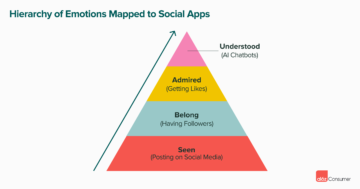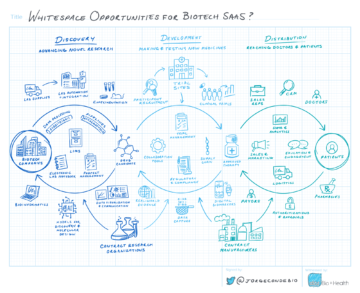
General Partner Connie Chan on how leading brands are using AI and other technology to combine the serendipitous discovery of offline shopping with the infinite options of online shopping.
Today, most of the Western world revolves around search-based online commerce. This means that most shoppers type directly what they want into a store search bar, add their desired goods to their carts, and then check out. The benefit of search-based commerce—and why it’s been so dominant over the years—is that consumers can quickly and efficiently buy exactly what they’re looking for.
But what about the products that you’re not looking for? Search-based commerce deprives consumers of one of the most delightful parts of shopping: discovery. Who among us hasn’t walked into a Target looking for one item, but walked out with a dozen? Retailers and brands are now using artificial intelligence to collect data from your own purchase history, and others’, to provide you with an endless list of desirable things that you might want to buy.
This means that, in the near future, commerce platforms should not only be able to recommend a shirt that you like, but a shirt with your preferred neckline, in your favorite color, at a 30% discount—because the algorithm knows that you’re more likely to purchase a piece of clothing you absolutely love that also happens to be on sale.
This evolution in product discovery—and how it will lead to more conversions and fewer returns—is the future of commerce.
The next generation of marketplace winners will be the brands that successfully combine the joyous discovery of offline shopping with the infinite options of online shopping. Click To Tweet
Discovery-based shopping works with photos, short video, and livestream video. The shopping app Temu, for example, serves up personalized, gamified feeds of products and shopping deals. TikTok and YouTube, of course, have popularized unboxing videos and testimonials. And apps like Whatnot allow sellers to make sales in real time through livestreams.
Discovery-based shopping is often driven by influencers and social media. On Facebook groups and group chats, for example, shoppers can get feedback from both sellers and other buyers, who can influence their own buying behavior. The growth of discovery-based commerce presents a fantastic opportunity for brands to make shopping fun again for consumers. After all, shopping is supposed to be fun.
But discovery-based shopping can also be a more convenient way for brands to offload overstock. As Chinese shopping platforms have shown us, shoppers love a good deal. If retailers can surface excess inventory as limited-time sales or offer special coupons to jettison unsold products, then those items are more likely to be seen and purchased.
In the U.S., our discovery-based shopping options are still limited. But it’s only a matter of time before smart retailers figure out how to more effectively bring the offline shopping experience online.
Once brands master discovery-based commerce and retailers start surfacing products they know their customers will be interested in, how will they ensure that that interest turns into an actual sale?
The answer, again, lies at the intersection of offline and online shopping. Retailers need to bring the benefits of offline shopping—such as using a fitting room to guarantee that clothes will fit or talking to a sales rep to understand the merits and drawbacks of specific product models—to the online experience.
In short, the more personalized information consumers can get about an online purchase, the higher the conversion rates. One easy way of doing this is through social proof: getting the validation of friends and family. In China, for example, you can put several items into your online shopping cart and send a link of those items to your friends so that they can leave comments. Other tools for more personalized shopping, such as augmented reality dressing rooms or body-scan technology, can also help instill confidence in a purchase.
In the offline world, many shoppers feel an obligation to make a purchase if they’ve been successfully helped by a human sales representative. Through technology, this interaction can be replicated online. Increasingly, retailers today are training online sales reps to answer questions and provide relevant information to shoppers, whether in private group chats or customer chat portals.
Live-shopping is another promising way to convert interested shoppers. Through video, shoppers can see a product in action, get tutorials on how to use certain products, or participate in giveaways. These are all behaviors that can increase a shopper’s confidence in their purchase.
Live-shopping also increases FOMO. If there’s only one Birkin bag or limited-edition Pokemon card available for purchase, once it’s sold, it’s gone. And seeing like-minded shoppers purchase a product reinforces a sense of trust, desirability, and community—ultimately helping convert a shopping cart into a purchase.
The third step in the modern-day ecommerce experience is ensuring that a sale that was spurred by improved discovery remains a sale and doesn’t become a return. Excess inventory costs companies hundreds of millions of dollars a year and negatively impacts the environment. For retailers, the easiest way to combat this issue is to use new consumer technologies that help shoppers get the product variety and information they want.
By improving product discovery and conversion, retailers can surface more relevant products to shoppers, who can then make more informed decisions and feel more confident in their purchases. By giving consumers access to the right information, return rates will drop. As a result, consumers will be less likely to engage in wasteful behavior, such as buying 10 jackets, only to return nine of them and keep the one that fits the best.
Additionally, more brands are introducing AI powered software into their purchasing decisions, which factors in real-time data such as sales, sell-through, and conversion. Such software can help retailers better predict returns and manage the excess inventory in their warehouses.
Largely driven by sustainably-minded gen Z shoppers, companies like Target, Lululemon, Gucci, and Rent the Runway are also adopting tech-enabled resale programs and beefing up their focus on secondhand shoppers. And there are multiple startups powering various types of resale marketplaces, which match individuals, liquidation centers, or donation centers with resellers who can offload excess inventory (often for a cut of the profit).
Across all three phases of modern ecommerce, these companies are using technology to personalize the online shopping experience, make the process more interactive, and increase the conviction in a purchase before and after buying. By combining the browsing experience of offline shopping with the ease and engagement of online shopping, these companies are attempting to create a virtuous cycle of product discovery.
After all, who knows what else you might find…
* * *
The views expressed here are those of the individual AH Capital Management, L.L.C. (“a16z”) personnel quoted and are not the views of a16z or its affiliates. Certain information contained in here has been obtained from third-party sources, including from portfolio companies of funds managed by a16z. While taken from sources believed to be reliable, a16z has not independently verified such information and makes no representations about the enduring accuracy of the information or its appropriateness for a given situation. In addition, this content may include third-party advertisements; a16z has not reviewed such advertisements and does not endorse any advertising content contained therein.
This content is provided for informational purposes only, and should not be relied upon as legal, business, investment, or tax advice. You should consult your own advisers as to those matters. References to any securities or digital assets are for illustrative purposes only, and do not constitute an investment recommendation or offer to provide investment advisory services. Furthermore, this content is not directed at nor intended for use by any investors or prospective investors, and may not under any circumstances be relied upon when making a decision to invest in any fund managed by a16z. (An offering to invest in an a16z fund will be made only by the private placement memorandum, subscription agreement, and other relevant documentation of any such fund and should be read in their entirety.) Any investments or portfolio companies mentioned, referred to, or described are not representative of all investments in vehicles managed by a16z, and there can be no assurance that the investments will be profitable or that other investments made in the future will have similar characteristics or results. A list of investments made by funds managed by Andreessen Horowitz (excluding investments for which the issuer has not provided permission for a16z to disclose publicly as well as unannounced investments in publicly traded digital assets) is available at https://a16z.com/investments/.
Charts and graphs provided within are for informational purposes solely and should not be relied upon when making any investment decision. Past performance is not indicative of future results. The content speaks only as of the date indicated. Any projections, estimates, forecasts, targets, prospects, and/or opinions expressed in these materials are subject to change without notice and may differ or be contrary to opinions expressed by others. Please see https://a16z.com/disclosures for additional important information.
- SEO Powered Content & PR Distribution. Get Amplified Today.
- Platoblockchain. Web3 Metaverse Intelligence. Knowledge Amplified. Access Here.
- Source: https://a16z.com/2023/03/23/the-future-of-ecommerce/
- :is
- $UP
- 10
- a
- a16z
- Able
- About
- absolutely
- access
- accuracy
- Action
- addition
- Additional
- Adopting
- Advertising
- advice
- advisory
- advisory services
- affiliates
- After
- Agreement
- AI
- algorithm
- All
- among
- among us
- and
- Andreessen
- Andreessen Horowitz
- Another
- answer
- app
- apps
- ARE
- around
- AS
- Assets
- assurance
- At
- attempting
- available
- bag
- bar
- BE
- become
- becomes
- before
- believed
- benefit
- benefits
- BEST
- Better
- brands
- bring
- Browsing
- business
- buy
- buyers
- Buying
- by
- CAN
- Can Get
- capital
- card
- Centers
- certain
- change
- characteristics
- check
- China
- chinese
- circumstances
- clothes
- Clothing
- CNBC
- collect
- color
- combat
- combine
- combining
- comments
- Commerce
- Companies
- confidence
- confident
- constitute
- consumer
- Consumers
- content
- contrary
- Convenient
- Conversion
- conversions
- convert
- conviction
- Costs
- course
- create
- customer
- Customers
- Cut
- cycle
- data
- Date
- deal
- Deals
- decision
- decisions
- delightful
- described
- differ
- digital
- Digital Assets
- directed
- directly
- Disclose
- discovery
- documentation
- Doesn’t
- doing
- dollars
- dominant
- donation
- dozen
- drawbacks
- driven
- Drop
- easiest
- easy
- ecommerce
- effectively
- efficiently
- embedded
- Endless
- endorse
- enduring
- engage
- engagement
- ensure
- ensuring
- entirety
- Environment
- estimates
- evolution
- example
- excluding
- experience
- expressed
- factors
- family
- fantastic
- Favorite
- feedback
- Figure
- fit
- fitting
- Focus
- FOMO
- For
- For Consumers
- Forbes
- friends
- from
- FT
- fund
- funds
- Furthermore
- future
- generation
- get
- getting
- giveaways
- given
- Giving
- good
- goods
- graphs
- Group
- Group’s
- Growth
- guarantee
- happens
- Have
- help
- helped
- helping
- here
- higher
- history
- Horowitz
- How
- How To
- HTML
- HTTPS
- human
- Impacts
- important
- improved
- improving
- in
- include
- Including
- Increase
- Increases
- increasingly
- independently
- indicated
- individual
- individuals
- influence
- information
- Informational
- informed
- interaction
- interactive
- interest
- interested
- intersection
- introducing
- inventory
- Invest
- investment
- investment advisory
- Investments
- Investors
- issue
- Issuer
- IT
- items
- ITS
- Keep
- Know
- lead
- leading
- Leave
- Legal
- like
- like-minded
- likely
- Limited
- limited-edition
- limited-time
- LINK
- Liquidation
- List
- looking
- love
- made
- make
- make sales
- MAKES
- Making
- manage
- managed
- management
- many
- marketplace
- marketplaces
- master
- Match
- materials
- Matter
- Matters
- means
- Memorandum
- mentioned
- might
- Modern
- more
- most
- multiple
- Near
- Need
- negatively
- New
- next
- obligation
- obtained
- of
- offer
- offering
- offline
- on
- ONE
- online
- online shopping
- Opinions
- Opportunity
- Options
- Other
- Others
- Overstock
- own
- participate
- partner
- parts
- past
- performance
- permission
- personalize
- Personalized
- Personnel
- piece
- Platforms
- plato
- Plato Data Intelligence
- PlatoData
- please
- pokemon
- portfolio
- powered
- Powering
- predict
- preferred
- presents
- private
- process
- Product
- Products
- Profit
- profitable
- Programs
- projections
- promising
- prospects
- provide
- provided
- publicly
- purchase
- purchased
- purchases
- purchasing
- purposes
- put
- Questions
- quickly
- Rates
- Read
- real
- real-time
- real-time data
- recommend
- Recommendation
- references
- referred
- relevant
- reliable
- replicated
- representative
- result
- Results
- retailers
- return
- returns
- reviewed
- Room
- Rooms
- s
- sale
- sales
- Search
- Securities
- seeing
- Sellers
- sense
- serves
- Services
- several
- Shoppers
- Shopping
- shopping cart
- Short
- should
- similar
- situation
- smart
- So
- Social
- Software
- sold
- Sources
- Speaks
- special
- specific
- start
- Startups
- Step
- Still
- store
- subject
- subscription
- Successfully
- such
- supposed
- Surface
- talking
- Target
- targets
- tax
- tech-enabled
- Technologies
- Technology
- that
- The
- The Future
- the information
- their
- Them
- therein
- These
- things
- Third
- third-party
- three
- Through
- time
- to
- today
- tools
- traded
- Training
- true
- Trust
- types
- u.s.
- under
- understand
- us
- use
- validation
- variety
- various
- Vehicles
- verified
- Video
- Videos
- views
- walked
- Way..
- WELL
- Western
- Western World
- What
- whether
- which
- while
- WHO
- will
- winners
- with
- within
- without
- works
- world
- Your
- youtube
- zephyrnet












